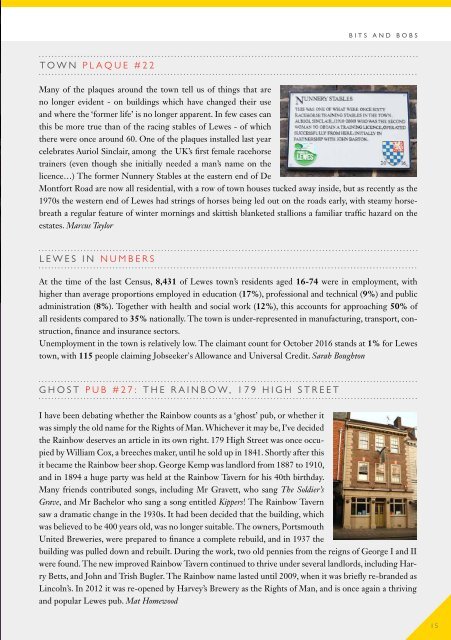Create successful ePaper yourself
Turn your PDF publications into a flip-book with our unique Google optimized e-Paper software.
BITS AND BOBS<br />
TOWN PLAQUE #22<br />
Many of the plaques around the town tell us of things that are<br />
no longer evident - on buildings which have changed their use<br />
and where the ‘former life’ is no longer apparent. In few cases can<br />
this be more true than of the racing stables of <strong>Lewes</strong> - of which<br />
there were once around 60. One of the plaques installed last year<br />
celebrates Auriol Sinclair, among the UK’s first female racehorse<br />
trainers (even though she initially needed a man’s name on the<br />
licence…) The former Nunnery Stables at the eastern end of De<br />
Montfort Road are now all residential, with a row of town houses tucked away inside, but as recently as the<br />
1970s the western end of <strong>Lewes</strong> had strings of horses being led out on the roads early, with steamy horsebreath<br />
a regular feature of winter mornings and skittish blanketed stallions a familiar traffic hazard on the<br />
estates. Marcus Taylor<br />
LEWES IN NUMBERS<br />
At the time of the last Census, 8,431 of <strong>Lewes</strong> town’s residents aged 16-74 were in employment, with<br />
higher than average proportions employed in education (17%), professional and technical (9%) and public<br />
administration (8%). Together with health and social work (12%), this accounts for approaching 50% of<br />
all residents compared to 35% nationally. The town is under-represented in manufacturing, transport, construction,<br />
finance and insurance sectors.<br />
Unemployment in the town is relatively low. The claimant count for October 2016 stands at 1% for <strong>Lewes</strong><br />
town, with 115 people claiming Jobseeker's Allowance and Universal Credit. Sarah Boughton<br />
GHOST PUB #27: THE RAINBOW, 179 HIGH STREET<br />
I have been debating whether the Rainbow counts as a ‘ghost’ pub, or whether it<br />
was simply the old name for the Rights of Man. Whichever it may be, I’ve decided<br />
the Rainbow deserves an article in its own right. 179 High Street was once occupied<br />
by William Cox, a breeches maker, until he sold up in 1841. Shortly after this<br />
it became the Rainbow beer shop. George Kemp was landlord from 1887 to 1910,<br />
and in 1894 a huge party was held at the Rainbow Tavern for his 40th birthday.<br />
Many friends contributed songs, including Mr Gravett, who sang The Soldier’s<br />
Grave, and Mr Bachelor who sang a song entitled Kippers! The Rainbow Tavern<br />
saw a dramatic change in the 1930s. It had been decided that the building, which<br />
was believed to be 400 years old, was no longer suitable. The owners, Portsmouth<br />
United Breweries, were prepared to finance a complete rebuild, and in 1937 the<br />
building was pulled down and rebuilt. During the work, two old pennies from the reigns of George I and II<br />
were found. The new improved Rainbow Tavern continued to thrive under several landlords, including Harry<br />
Betts, and John and Trish Bugler. The Rainbow name lasted until 2009, when it was briefly re-branded as<br />
Lincoln’s. In 2012 it was re-opened by Harvey’s Brewery as the Rights of Man, and is once again a thriving<br />
and popular <strong>Lewes</strong> pub. Mat Homewood<br />
15


















